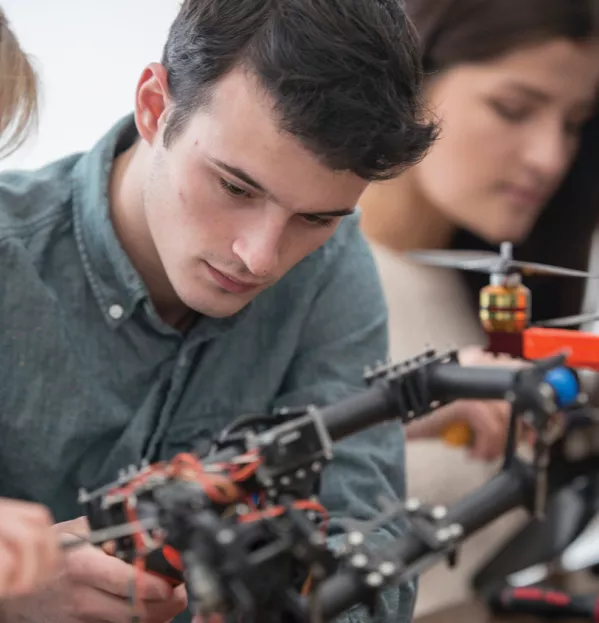How colleges can educate the workforce of tomorrow

The workplace is changing at such a rapid pace that it is difficult to make predictions about what tomorrow might bring. Many of the jobs that are commonplace today in digital marketing or app design, for example, did not exist 10 years ago.
When today’s students enter the workforce, there will in all probability be a whole host of new roles to aspire to. Self-drive car mechanic or drone engineer anyone?
It falls to the FE sector to provide the core of the nation’s workforce of the future. And I would hazard a guess that these workers will need to be natural collaborators, problem-solvers and out-of-the-box thinkers.
Yet, if the institutions we work in are designed around traditional models of teaching and learning, how can we develop our learners so that they can take advantage of the new employment landscape?
No place for chalk and talk
We need to move away from classrooms that have not progressed since the days of chalk and talk - with a desk at the front, where teaching remains in the hands of teachers and students are passive recipients of information, rather than active learners.
Similarly, subject faculties are often entirely separate entities, dividing the chefs from the software developers, so never the twain shall meet.
This traditional scenario simply doesn’t represent the workplace that our students will enter - the old-style office is just as last century as the classroom. In the future, chefs will probably need to work hand-in-hand with software developers to create apps to promote their restaurant or hire a social media expert to help them develop their advertising strategy.
A different type of teaching
To get students ready to compete in the global market and thrive in the sharing economy, we need to move towards self-directed learning. So where does this leave teachers?
Many teaching staff in our college have been with us for 15 years or more; they have a wealth of experience and vast pools of knowledge. However, their role is changing. They are becoming expert facilitators of learning and they continue to encourage their students to take more control.
We are currently at a crossroads in our college. We are transforming it from the bottom up to ensure that we are developing learners ready for the future. But it would be difficult to expect this level of change without the whole system, staff training and buildings being transformed.
Collaboration is key
In a world where collaboration is key, teaching staff will become the conduit needed to bridge traditional subject barriers and spark ideas. We might see sport and media students being brought together to film ball strikes on a green screen and find the best angle for a penalty, for example.
Today’s millennial students are far beyond being digital natives. Their natural state is to have two or three screens open at once, completing a multitude of tasks simultaneously. So FE tutors need the ability to harness their students’ digital skills and help them to access and share knowledge with peers, generating discussions for a more interactive and memorable approach to learning.
Tutors must be empowered by colleges to become facilitators, encouraging skills-based learning by continuing to invite guest experts to provide students with the practical skills that new industries demand. Or allowing students to work collaboratively across departments and with local businesses, or other schools, colleges or universities to solve real-world problems while they learn.
Creating project-based learning is one way to do this: developing a multidisciplinary team designed to solve a real-world problem for an industry or employer. This brings learning and teaching to life, theory to practice and develops experience on lessons learned, along with the softer skills of teamwork, communication and negotiation.
But it’s surprising how much physical and structural change is needed to deliver this.
New learning spaces
Today’s workplace is populated by flexible, mobile workers, doing their jobs any time, any place, anywhere.
Our college increasingly needs to reflect this. Old classroom walls are being removed to create incubation hubs based on the spaces used by business start-ups, with wireless infrastructure so students can plug their technology in and make projects come to life, literally, anywhere they happen to be. Even the old-fashioned college refectory no longer seems fit for purpose. Some of the best ideas come to us while we’re relaxing with a coffee, so new food halls should enable students to have breakout sessions, research a new topic or FaceTime a student at a different site.
Building tomorrow’s workforce is no small task for the sector, but with a fresh perspective we’ll be able to ensure our drone engineers get the skills to work in whatever economy they choose once they leave education.
Garry Phillips is the chief executive of Ealing, Hammersmith and West London’s College
You need a Tes subscription to read this article
Subscribe now to read this article and get other subscriber-only content:
- Unlimited access to all Tes magazine content
- Exclusive subscriber-only stories
- Award-winning email newsletters
Already a subscriber? Log in
You need a subscription to read this article
Subscribe now to read this article and get other subscriber-only content, including:
- Unlimited access to all Tes magazine content
- Exclusive subscriber-only stories
- Award-winning email newsletters